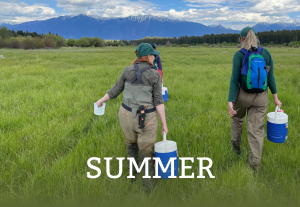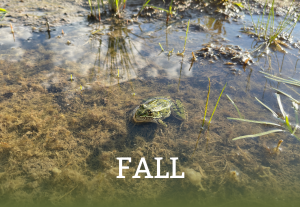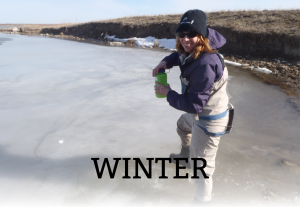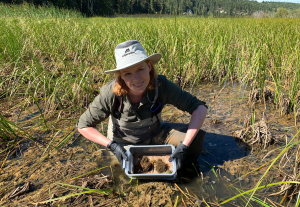What a year of frog conservation looks like
February 22, 2023
By Lea Randall, Interim Senior Manager of Conservation Operations

As my boots sloshed through the muddy waters of British Columbia’s (B.C.) wetlands in early spring last year, I wondered what our northern leopard frog field season would bring. Once widespread across the country, northern leopard frog populations have been in decline since the 1970’s due to habitat loss, invasive species, and disease. Today, only one wild population remains in B.C. in the Creston Valley.
Last year marked the first time our team released frogs at a new reintroduction site. This new site featured excellent habitat for northern leopard frogs and our team was excited to see how tadpoles released at this new site would feed, grow, overwinter, and reproduce. While there were no frogs to observe in the wild at this site yet, I wanted to check out the soon-to-be-wild-home for the northern leopard frogs that I work with.
The network of wetlands divided by lush vegetation seems like northern leopard frog paradise! The dense cattails and bulrushes provide cover from any potential predators. The channels and streams tricking out of the wetlands offer a calm environment for frogs to overwinter in. Amphibians like the northern leopard frog undergo a state of dormancy called ‘brumation’ during the winter. During this period of slowing their body down, it’s important for the frogs to have slow waterways where they can wedge themselves in and rest.
After walking, wading, and wallowing through these wetlands, I journeyed back to Alberta feeling optimistic.

It might seem like a simple task of moving frogs from one site to another, but releasing northern leopard frogs is actually a highly collaborative effort involving many organizations and individuals! We worked together with collaborators in B.C. to collect northern leopard frog eggs and head-started tadpoles. Head-starting is a process where tadpoles from the wild are brought under human care to give them a little head-start in their survival. All told, we released 1,929 tadpoles in 2022 working together with our partners.
As the season progressed throughout last year, things were looking up for northern leopard frogs when the team and I surveyed frogs from July to September at our new reintroduction site. With these surveys, we’re looking to see how many of the tadpoles that we released are entering the next stage of their life cycle.
During these surveys, I walked along the perimeter of wetlands, with vigilant eyes on both the water and the surrounding vegetation. As northern leopard frogs are semi-aquatic frogs, terrestrial life stages can often be found a couple of meters or more away from the water!

We continued to undertake these surveys for a total of ten weeks. In our final survey week, we observed 77 northern leopard frogs, with the largest frog weighing in at a whopping 52.25 g! Usually, northern leopard frogs don’t reach this size until they are around 2-3 years old. We made 855 observations of northern leopard frogs out in and around the wetlands.
We also completed surveys in late October and early November at suspected overwintering sites in the area to determine whether the reintroduced frogs had located and were using the overwintering habitat. On these surveys, nine frogs were observed along the creek at the north edge of the property and one in a spring-fed channel at the south edge.
We now had pages and pages of data to go through including frog body size, weight, photo identification, and where they were found. We entered all the data collected during the survey period into our databases and checked it over for quality control.
Wrap-up of the field season also means getting to do all the clean-up! We take this time to ensure that all our equipment is cleaned and stored away properly for use next year. Field season wrap-up often includes ordering replacement gear and thinking about what additional gear and equipment we may need for the next field season.

Finally, with data in our hand, we’re ready to start our analysis. First, we needed to gain an accurate estimate of how many individual frogs we observed. We did this with help from the photos we took out in the field. Individual northern leopard frogs all have a unique spot pattern. By comparing these spot patterns across the photos that we took, we determined how many northern leopard frogs were actually present in the wetlands. From the 855 frogs we observed in the field, we were able to identify 326 unique individuals.
This information also allowed us to run an analysis to estimate the size of the population, which we used to calculate survival rates from the tadpole to young-of-year life stage. We also planned to complete some additional analyses in the future to look at body condition and growth rates of frogs between wetlands, as well as potentially looking at the influence of wetland characteristics such as temperature during tadpole development on size and condition of young-of-year frogs.
During this time, we also began to plan for the 2023 field season. We organized field gear, calibrated scales, tested microphones on automated recorders, developed protocols, planned surveys, and assessed what types of research or habitat questions we might want to answer. With all this work to be done, it’s never too early to get started!
Looking ahead at 2023
Despite these successes, there are still challenges for northern leopard frogs to overcome on the road to recovery. While we saw positive signs at the new site, this year we hope to better understand the challenges and opportunities at this site.
The road to recovery is long and filled with both successes and setbacks, but there is still hope. We hope to strengthen our conservation breeding efforts to continue contributing northern leopard frogs to populations in the wild, ensuring their persistence. These frogs play a vital role in the wetlands where they live, transferring nutrients between terrestrial and aquatic ecosystems. They are also an indicator species, reflecting the health of the habitats they call home. Our community of supporters allows this critical conservation work to continue and will help ensure northern leopard frogs survive into the future. Working together, we look forward to someday hearing the mating calls of northern leopard frogs in wetlands across British Columbia.

What else is happening in the world of wildlife conservation?
